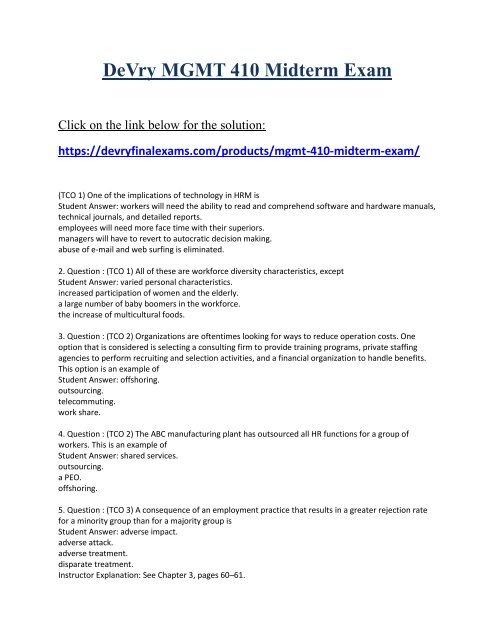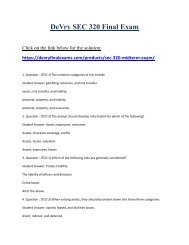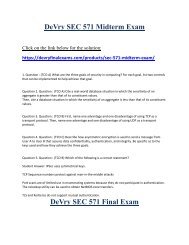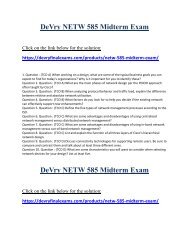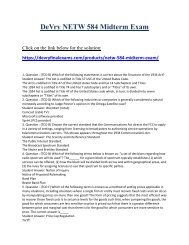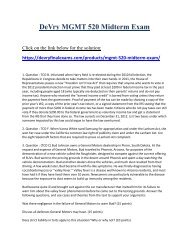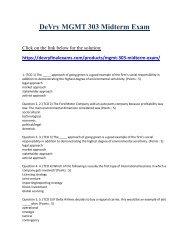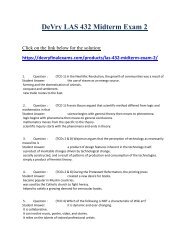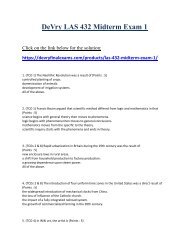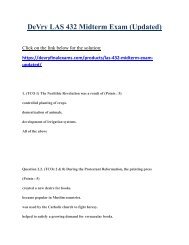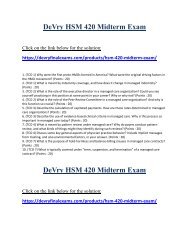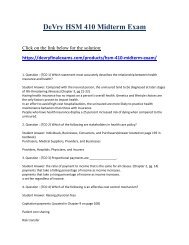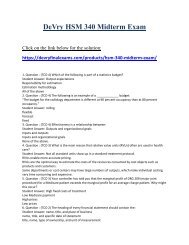MGMT 410 Midterm Exam
Create successful ePaper yourself
Turn your PDF publications into a flip-book with our unique Google optimized e-Paper software.
DeVry <strong>MGMT</strong> <strong>410</strong> <strong>Midterm</strong> <strong>Exam</strong><br />
Click on the link below for the solution:<br />
https://devryfinalexams.com/products/mgmt-<strong>410</strong>-midterm-exam/<br />
(TCO 1) One of the implications of technology in HRM is<br />
Student Answer: workers will need the ability to read and comprehend software and hardware manuals,<br />
technical journals, and detailed reports.<br />
employees will need more face time with their superiors.<br />
managers will have to revert to autocratic decision making.<br />
abuse of e-mail and web surfing is eliminated.<br />
2. Question : (TCO 1) All of these are workforce diversity characteristics, except<br />
Student Answer: varied personal characteristics.<br />
increased participation of women and the elderly.<br />
a large number of baby boomers in the workforce.<br />
the increase of multicultural foods.<br />
3. Question : (TCO 2) Organizations are oftentimes looking for ways to reduce operation costs. One<br />
option that is considered is selecting a consulting firm to provide training programs, private staffing<br />
agencies to perform recruiting and selection activities, and a financial organization to handle benefits.<br />
This option is an example of<br />
Student Answer: offshoring.<br />
outsourcing.<br />
telecommuting.<br />
work share.<br />
4. Question : (TCO 2) The ABC manufacturing plant has outsourced all HR functions for a group of<br />
workers. This is an example of<br />
Student Answer: shared services.<br />
outsourcing.<br />
a PEO.<br />
offshoring.<br />
5. Question : (TCO 3) A consequence of an employment practice that results in a greater rejection rate<br />
for a minority group than for a majority group is<br />
Student Answer: adverse impact.<br />
adverse attack.<br />
adverse treatment.<br />
disparate treatment.<br />
Instructor Explanation: See Chapter 3, pages 60–61.
Points Received: 0 of 4<br />
Comments:<br />
6. Question : (TCO 3) Under Title VII, the second defense against discriminatory charges is<br />
Student Answer: BBQ.<br />
BFOQ.<br />
SOX.<br />
BBOQ.<br />
7. Question : (TCO 3) Which of the following laws extended leave for family matters?<br />
Student Answer: USERRA<br />
FADA<br />
FMLA<br />
FLRA<br />
PDA<br />
8. Question : (TCO 4) Reagan has worked for 22 years at a 20-employee branch of a large auto parts<br />
chain. Business has been very bad lately, and there are rumors of consolidation, reorganization, and<br />
even bankruptcy. What protection is Reagan given under the Worker Adjustment and Retraining<br />
Notification Act?<br />
Student Answer: With less than 25 years seniority, he can be laid off with less than 6 months notice.<br />
Reagan will be given 60 days warning if his location closes.<br />
No protection; his industry is not covered by the act.<br />
No protection; his branch is too small for coverage.<br />
9. Question : (TCO 5) When a job analyst watches employees directly or reviews films of workers on the<br />
job, which analysis method is being used?<br />
Student Answer: Group view method<br />
Observation method<br />
Structured method<br />
Individual view method<br />
10. Question : (TCO 4) Which of the following is not one of the guidelines for administering discipline?<br />
Student Answer: Following the hot stove rule<br />
Provide ample warning<br />
Be consistent and personal<br />
Making discipline actions progressive<br />
11. Question : (TCO 5) This job analysis method requires job incumbents to record their daily activities.<br />
Student Answer: Journal method<br />
Observation method<br />
Diary method<br />
Technical conference method<br />
12. Question : (TCO 5) Where does job analysis occur in the strategic planning process?<br />
Student Answer: Before corporate goals and objectives are established<br />
After corporate goals and objectives are established<br />
After the labor supply and demand are compared
Before organizational mission is defined<br />
13. Question : (TCO 6) Jane is the director of recruiting for a large corporation. Which of the following is<br />
a warning signal that her efforts are not effective?<br />
Student Answer: Recruiting costs have increased 5% over the last 3 years.<br />
Because 25% of resumes are received through the Internet.<br />
Jane’s secretary spends more time acknowledging ad responses from qualified applicants than she did a<br />
year ago.<br />
Jane’s secretary spends more time acknowledging ad responses from under qualified applicants than<br />
she did a year ago.<br />
14. Question : (TCO 6) A good recruiting program is indicated by which of the following?<br />
Student Answer: More native speakers apply and fewer foreign nationals apply.<br />
More qualified applicants apply and fewer unqualified applicants apply.<br />
All applicants are encouraged to apply for jobs.<br />
Recruiting is phased out for women and minority applicants.<br />
15. Question : (TCO 6) Which is not a step in the selection process?<br />
Student Answer: Initial screening<br />
Background investigation<br />
Pre-employment test<br />
Pending application form<br />
16. Question : (TCO 6) Which of the following is a recruitment alternative that keeps employees longer<br />
than temporary employees and are employed by a firm.<br />
Student Answer: Leased employees<br />
Independent contractors<br />
Self-employed<br />
Temporary employees<br />
17. Question : (TCO 7) In the selection process, a background examination should occur after<br />
Student Answer: a medical/physical examination.<br />
an initial screening.<br />
a conditional job offer.<br />
a completed application.<br />
18. Question : (TCO 7) An activity included in pre-employment testing that creates a miniature replica of<br />
a job is called<br />
Student Answer: a performance simulation test.<br />
a work sampling.<br />
an assessment center.<br />
a global testing.<br />
19. Question : (TCO 7) Which option is designed to probe areas not easily addressed by the application<br />
form or tests?<br />
Student Answer: Comprehensive interview<br />
Weighted application forms<br />
Background screening
Initial screening<br />
20. Question : (TCO 8) Which is not an on-the-job training method?<br />
Student Answer: Job rotation<br />
Simulations<br />
Apprenticeships<br />
Internships<br />
21. Question : (TCO 8) What is an employee development method that involves exercises such as case<br />
studies, decision games, and role plays?<br />
Student Answer: Job rotation<br />
Adventure training<br />
Simulations<br />
Virtual reality<br />
22. Question : (TCO 8) Shannon is in line for a senior vice president position at a large hotel<br />
conglomerate. She has just received a letter appointing her to the national environmental task force for<br />
water and electricity conservation. What is happening to her career?<br />
Student Answer: Job rotation<br />
Adjusted<br />
Committee assignment<br />
Survival training<br />
23. Question : (TCO 9) Hector is a research scientist in a large company. He refuses to go to staff<br />
meetings but volunteers to attend conventions where he receives recognition for his accomplishments.<br />
He holds 17 patents (more than two for each year he has been with his company, and they are proudly<br />
displayed on his office wall), but will not work with his manager on quarterly goals. What is Hector’s<br />
Holland vocational preferences type?<br />
Student Answer: Realistic-investigative-enterprising<br />
Social-enterprising-conventional<br />
Social-conventional-realistic<br />
Investigative-conventional-artistic<br />
Realistic-conventional-artistic<br />
24. Question : (TCO 9) Sarah has had continuous movement in performance and promotion. She now<br />
wants to be vice president of human resources by the time she’s 34 to 40 years old. Her next goal is to<br />
be CEO by the time she’s 55 after being VP. However, she seems to be just holding on to the VP position.<br />
She is at what career stage?<br />
Student Answer: Exploration<br />
Establishment<br />
Midcareer<br />
Decline<br />
25. Question : (TCO 9) Melissa prefers solitary work to large groups, asking questions rather than<br />
answering them, and making her own rules instead of following others. What Holland vocational<br />
preference model best represents her?<br />
Student Answer: Realistic-investigative-artistic<br />
Social-enterprising-conventional
Social-conventional-realistic<br />
Realistic-conventional-artistic<br />
(TCO 3) Explain the need for equal employment opportunity laws in organizations. How has it impacted<br />
HRM? Defend your position.<br />
Explain the benefits of online recruiting.<br />
You have just been promoted at the BBB Company and now have the responsibility of the employee<br />
orientation program. What components should be covered in the program? Explain what would be<br />
covered in your employee orientation program.<br />
DeVry <strong>MGMT</strong> <strong>410</strong> <strong>Midterm</strong> <strong>Exam</strong><br />
Click on the link below for the solution:<br />
https://devryfinalexams.com/products/mgmt-<strong>410</strong>-midterm-exam/


